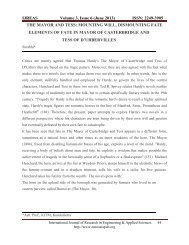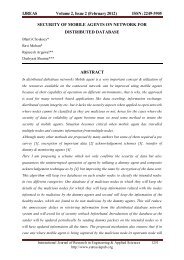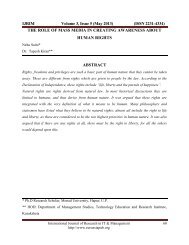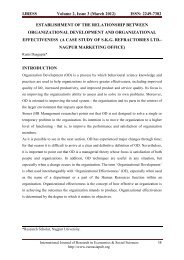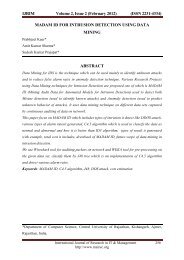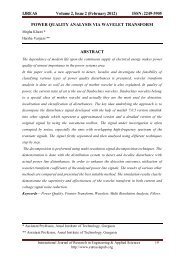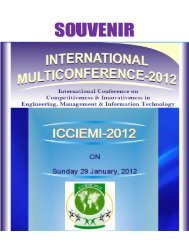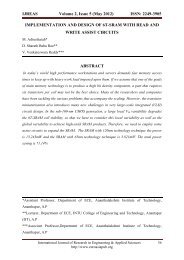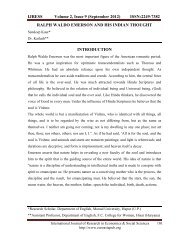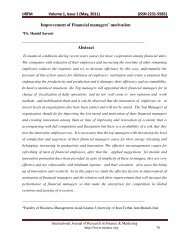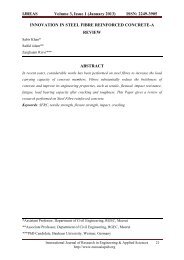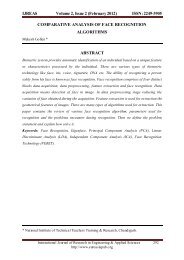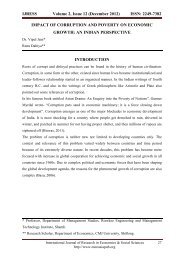gaining the competitive edge through crm - Euroasiapub.org
gaining the competitive edge through crm - Euroasiapub.org
gaining the competitive edge through crm - Euroasiapub.org
Create successful ePaper yourself
Turn your PDF publications into a flip-book with our unique Google optimized e-Paper software.
IJRFM Volume 1, Issue 3 (July, 2011) (ISSN 2231-5985)GAINING THE COMPETITIVE EDGE THROUGH CRM – A STUDYON PRIVATE SECTOR BANKSYogita Narang*Atul Narang**Dr. Shalini Nigam**ABSTRACTCustomer relationship management (CRM), being disciplined and holistic approach inidentifying <strong>the</strong> tastes and preferences on individual basis to enhance relationship over <strong>the</strong>customer’s life, is <strong>the</strong> buzz word for <strong>competitive</strong> advantage and so <strong>the</strong> companies arespending enormous resources on it. In CRM every customer is viewed on his life time value,and <strong>the</strong> realization is loud and clear that not only customer retention but customersatisfaction is more important than just customer acquisition for a transaction. In real termsCRM is a philosophy and <strong>the</strong> software solution part is a mere tool to aid betterimplementation of <strong>the</strong> philosophy. CRM goes way beyond a software solution. The presentlevel of MIS covers, information needed for control, performance monitoring, decisionmaking etc. and encompasses activities in administrative offices like processing of statutoryreturns, monthly/quarterly performance reports from branches, credit information personnelinventory, profit and loss accounts, funds management, and branch maintenance etc. Thepurpose of this research is to study <strong>the</strong> comparative use of CRM in various private sectorbanks. The study analyzes <strong>the</strong> perceptions of <strong>the</strong> customers regarding <strong>the</strong> impact of CRM onservice quality and evaluates <strong>the</strong> impact of CRM on customer retention. The results bring out<strong>the</strong> comparative ratings by customers, ICICI being rated first in implementation of CRM,HDFC rated first in service quality and customer retention. Keeping this challenge in mind itis an attempt to rediscover <strong>the</strong> power of upcoming Technologies of digital revolution in <strong>the</strong>field of banking sector – <strong>the</strong> challenges and <strong>the</strong>ir impact on future economy..*Research Scholar, Dept of Management, Dayalbagh Educational Institute, Agra, INDIA,**Ast. Proferssor, Dept of Management, Anand Engineering College, Agra, INDIA,***Associate Professor, Dept of Mgt, Dayalbagh Educational Institute, Agra, INDIA,International Journal of Research in Finance & Marketinghttp://www.mairec <strong>org</strong> 12
IJRFM Volume 1, Issue 3 (July, 2011) (ISSN 2231-5985)Key Words: Customer Relationship Management, Customer retention, service quality,<strong>competitive</strong> advantage, <strong>competitive</strong> strategy, Information TechnologyINTRODUCTIONCustomers Relations Management (CRM) helps in maintaining customer database andproviding better services. Over <strong>the</strong> last decade, firms across a wide variety of industries (forexample, banking, insurance, telephone, retailing and airlines to name a few) haveincreasingly focused on customer as opposed to a product or brand management strategy.With a customer management focus, <strong>the</strong>se firms have changed from a transactional to arelationship orientation, where <strong>the</strong>y differentiate customers as a function of <strong>the</strong> lifetime valueof <strong>the</strong> relationship to <strong>the</strong> firm (Blattberg and Deighton 1996; Peppers and Rogers 2001;Gupta et al. 2004). To implement such a customer relationship strategy, firms have not onlymade massive investments in information infrastructure to store and analyze customerinformation, but also changes in <strong>org</strong>anizational structure, employee incentives, accountingand operations management practices to facilitate <strong>the</strong> implementation of <strong>the</strong> strategy (Day2003). Yet, despite such massive investments in Customer Relationship Management (CRM),<strong>the</strong> current state of <strong>the</strong> literature provides feeble information on <strong>the</strong> usage of CRM strategiesby some of <strong>the</strong> good MNC’s private sector banks in developing country.CRM and its evolutionCRM is <strong>the</strong> business buzzword on <strong>the</strong> Internet <strong>the</strong>se days. Customer RelationshipManagement promises faster customer service at lower costs, higher customer satisfactionand from this, better customer retention and ultimately customer loyalty. Naturally, all this isdone in hope for more sales and profits. A management philosophy according to which acompany’s goals can be best achieved <strong>through</strong> identification and satisfaction of <strong>the</strong>customers' stated and unstated needs and wants. CRM is a computerized system foridentifying, targeting, acquiring, and retaining <strong>the</strong> best mix of customers. Customerrelationship management helps in profiling prospects, understanding <strong>the</strong>ir needs, and inbuilding relationships with <strong>the</strong>m by providing <strong>the</strong> most suitable products and enhancedcustomer service. It integrates back and front office systems to create a database of customercontacts, purchases, and technical support, among o<strong>the</strong>r things. This database helps <strong>the</strong>International Journal of Research in Finance & Marketinghttp://www.mairec <strong>org</strong> 13
IJRFM Volume 1, Issue 3 (July, 2011) (ISSN 2231-5985)company in presenting a unified face to its customers, and improve <strong>the</strong> quality of <strong>the</strong>relationship, while enabling customers to manage some information on <strong>the</strong>ir own.The Customer is King. This mantra, although used for a long time, has not been put intopractice until recently. F<strong>org</strong>et <strong>the</strong> notion of royal treatment; customers were not even treatedwith dignity by most <strong>org</strong>anizations. As recently as <strong>the</strong> 1970s and 80s, <strong>the</strong> concept ofcustomer support meant that <strong>org</strong>anizations were doing a favor by answering a few questionsfor <strong>the</strong> customer on <strong>the</strong> phone – after putting <strong>the</strong>m on hold for an hour! Standing in line tobuy something was common and expected. Remember when <strong>the</strong> customers had to go to <strong>the</strong>airports to buy tickets only because <strong>the</strong> airlines kept <strong>the</strong>m <strong>the</strong>re? Organizations simply losttouch with <strong>the</strong> realization – that <strong>the</strong>y existed because of <strong>the</strong>se customers.The 1990s brought two new concepts that challenged <strong>the</strong> prevailing business landscape:deregulation and <strong>the</strong> Internet. These forces brought down <strong>the</strong> barriers of entry resulting in anenvironment of intense competition. Stores faced competition from on-line start-ups.Traditional bricks-and-mortar banks fought for customers with online or virtual banks.Airline tickets were increasingly purchased from <strong>the</strong> convenience of your home. Theexplosion in information allowed consumers to compare features, and prices across multipleproviders. Products became commodities and prices could not be lowered fur<strong>the</strong>r to ensuresurvival. Customer service became <strong>the</strong> only major differentiator in many cases. Customersreceived what <strong>the</strong>y have always deserved – respect. The customer was now truly <strong>the</strong> king.Business customers, although always treated with more respect than individual consumers,were more or less ignored in <strong>the</strong> early stages of <strong>the</strong> Internet boom. The emphasis focused onexpanding <strong>the</strong> consumer base regardless of positive cash flow, revenues, and margins. Thedemise of many dot-coms brought an epiphany. Companies realized that <strong>the</strong>y needed to focuson <strong>the</strong>ir enterprise customers. The advent of e-CRM applications was <strong>the</strong> first big step towardproviding better support to <strong>the</strong> strategic business customers. Although <strong>the</strong>se solutionsprovided automated self-service to customers, <strong>the</strong>y still treated all customers <strong>the</strong> same.Fur<strong>the</strong>rmore, <strong>the</strong> focus of <strong>the</strong>se applications is more on improving call-center productivity.Clearly, <strong>the</strong>se applications add value and help many <strong>org</strong>anizations execute <strong>the</strong>ir CRMinitiatives. However, <strong>the</strong>y are not effective in meeting <strong>the</strong> needs of an <strong>org</strong>anization’s strategicInternational Journal of Research in Finance & Marketinghttp://www.mairec <strong>org</strong> 14
IJRFM Volume 1, Issue 3 (July, 2011) (ISSN 2231-5985)enterprise customers. Each enterprise customer has its own needs and craves personalizedsupport.More and more <strong>org</strong>anizations and companies have realized that <strong>the</strong>y need to put <strong>the</strong>ircustomers front and center and to support a robust strategic customer care process, includingprofiling customers, segmenting customers, researching customers, investing in technology,and managing customers (Brown, 2000).The paradigm shift brought lots of discussions on “relationship marketing” since <strong>the</strong> 1980s(Berry, 1983; Håkansson, 1982). Relationship marketing aims to identify, maintain and buildup a network with individual customers and to continuously streng<strong>the</strong>n <strong>the</strong> network for <strong>the</strong>mutual benefit of both sides <strong>through</strong> interactive, individualized and value-added contacts overa long period of time (Shani and Chalasani, 1992). However, relationship marketing focusesmainly on strategy, and lacks a holistic view of <strong>the</strong> business processes connected to it. CRMevolving from business processes emphasizes not only a comprehensive strategy, but also <strong>the</strong>process of acquiring, retaining and partnering with selective customers to create superiorvalue for <strong>the</strong> company and <strong>the</strong> customer (Parvatiyar and Sheth, 2000).Second, while companies and <strong>org</strong>anizations are making efforts to keep pace with <strong>the</strong>paradigm shift in marketing, customer needs, expectations and behaviors are also changing.Customers do not only want services; <strong>the</strong>y want “good” services, which possesscharacteristics like “ease of doing business, trust, responsiveness, web site navigability,problem resolution and all those o<strong>the</strong>r elements of good e-business that don't fit quite soneatly into a purely binary world” (Zemke and Connellan, 2001). Javalgi et al. (2006, p. 12)also pointed that “in today's hyper-<strong>competitive</strong> markets service firms must be marketoriented”. As “knowl<strong>edge</strong> is key to nurturing customer relationships” (Lavender, 2004),“market research plays a critical role in generating <strong>the</strong> needed data on which a marketorientation can be developed and implemented, which, in turn, can enhance <strong>the</strong> practice ofCRM” (Javalgi et al., 2006). Therefore, CRM is considered as a means of supplementingERP systems to match customers' needs and increase <strong>the</strong>ir satisfaction.CRM has been explained in various ways and <strong>the</strong> same applies about <strong>the</strong> understanding of <strong>the</strong><strong>org</strong>anizations and individuals about it.International Journal of Research in Finance & Marketinghttp://www.mairec <strong>org</strong> 15
IJRFM Volume 1, Issue 3 (July, 2011) (ISSN 2231-5985)As per a study by CRMGuru (www.<strong>crm</strong>guru.com) <strong>the</strong> following chart in Fig. 1 gives abreakup of what <strong>the</strong> customer understands about CRM:Fig.1: Source: “What is CRM?” Survey Results. www.<strong>crm</strong>guru.com: CRMGuru OnlineSurvey, 4400 Respondents, July 2003.So we can see that a major chunk of <strong>the</strong> respondents believe that CRM is about putting <strong>the</strong>customers at <strong>the</strong> heart of <strong>the</strong> business or employing a customer-centric approach. But whatdecides and drives <strong>the</strong> decision of how to approach <strong>the</strong> question of CRM implementationduring <strong>the</strong> whole lifecycle of a customer.Private Banking sectorIn 1994, <strong>the</strong> Reserve Bank of India issued a policy of liberalization to license limited numberof private banks, which came to be known as New Generation tech-savvy banks. Global TrustBank was, thus, <strong>the</strong> first private bank after liberalization; it was later amalgamated withOriental Bank of Commerce (OBC). Then Housing Development Finance CorporationLimited (HDFC) became <strong>the</strong> first (still existing) to receive an 'in principle' approval from <strong>the</strong>Reserve Bank of India (RBI) to set up a bank in <strong>the</strong> private sector.At present, Private Banks in India includes leading banks like ICICI Banks, ING VysyaInternational Journal of Research in Finance & Marketinghttp://www.mairec <strong>org</strong> 16
IJRFM Volume 1, Issue 3 (July, 2011) (ISSN 2231-5985)Bank, Jammu & Kashmir Bank, Karnataka Bank, Kotak Mahindra Bank, etc. Undoubtedly,being tech-savvy and full of expertise, private banks have played a major role in <strong>the</strong>development of Indian banking industry. They have made banking more efficient andcustomer friendly. In <strong>the</strong> process <strong>the</strong>y have jolted public sector banks out of complacency andforced <strong>the</strong>m to become more <strong>competitive</strong>.Dhanalakshmi BankThe foundation of Dhanalakshmi Bank Limited was laid down on 14th November 1927, in<strong>the</strong> Thrissur district of Kerala. A group of innovative entrepreneurs had started <strong>the</strong> bank witha capital of Rs.11,000 and only 7 employees.HDFC BankHousing Development Finance Corporation Limited, more popularly known as HDFC BankLtd, was established in <strong>the</strong> year 1994, as a part of <strong>the</strong> liberalization of <strong>the</strong> Indian BankingIndustry by Reserve Bank of India (RBI). It was one of <strong>the</strong> first banks to receive an 'inprinciple' approval from RBI, for setting up a bank in <strong>the</strong> private sector.ICICI BankICICI Bank started as a wholly owned subsidiary of ICICI Limited, an Indian financialinstitution, in 1994. Four years later, when <strong>the</strong> company offered ICICI Bank's shares to <strong>the</strong>public, ICICI's shareholding was reduced to 46%. In <strong>the</strong> year 2000, ICICI Bank offered madean equity offering in <strong>the</strong> form of ADRs on <strong>the</strong> New York Stock Exchange (NYSE)ING Vysya BankING Vysya Bank Ltd came into being in October 2002, when erstwhile Vysya Bank Ltd wasmerged with ING, a global financial powerhouse boasting of Dutch origin. Vysya Bank Ltd,one of initial banks to be set up in <strong>the</strong> private sector of India.Jammu & Kashmir BankThe origin of Jammu and Kashmir Bank Limited, more commonly referred to as J&K Bank,can be traced back to <strong>the</strong> year 1938, when it was established as <strong>the</strong> first state-owned bank inIndia. The bank was incorporated on 1st October 1938 and it was in <strong>the</strong> following year (moreprecisely on 4th July 1939) that it commenced its business, in Kashmir (India).International Journal of Research in Finance & Marketinghttp://www.mairec <strong>org</strong> 17
IJRFM Volume 1, Issue 3 (July, 2011) (ISSN 2231-5985)Karnataka BankKarnataka Bank Limited is a leading private sector bank in India. It was incorporated on 18thFebruary 1924 at Mangalore, a town located in <strong>the</strong> Kannada district of Karnataka. The bankemerged as a major player during <strong>the</strong> freedom movement of 20th Century India.Karur Vysya BankThe Karur Vysya Bank Limited commonly known as KVB was set up by Late Shri M.A.Venkatarama Chettiar and <strong>the</strong> Late Shri Athi Krishna Chettiar, <strong>the</strong> two great visionaries in1916 in Karur, a textile town in <strong>the</strong> Tamil Nadu state of India.Kotak Mahindra BankKotak Mahindra Bank is one of India's leading financial private banking institutions. It offersbanking solutions that covers almost every sphere of life. Some of its financial servicesinclude commercial banking, stock broking, mutual funds, life insurance and investmentbanking.UTI BankAxis Bank was formed as UTI when it was incorporated in 1994 when Government of Indiaallowed private players in <strong>the</strong> banking sector. The bank was sponsored toge<strong>the</strong>r by <strong>the</strong>administrator of <strong>the</strong> specified undertaking of <strong>the</strong> Unit Trust of India, Life InsuranceCorporation of India (LIC) and General Insurance Corporation ltd.YES BankYes Bank is one of <strong>the</strong> top most private Indian banks. Awarded by <strong>the</strong> only Greenfieldlicense award by RBI in last 14 years, this bank is established and run by Rana Kapoor andAshok Kapur with <strong>the</strong> financial support of Rabobank Nederland, <strong>the</strong> world's single AAArated private BankReview of LiteratureInternational Journal of Research in Finance & Marketinghttp://www.mairec <strong>org</strong> 18
IJRFM Volume 1, Issue 3 (July, 2011) (ISSN 2231-5985)The literature on Customer Relationship Management in <strong>the</strong> context of <strong>the</strong> Banking Industryof developed countries points towards <strong>the</strong> wide use of all financial services under one roofleading to relationship banking and CRM concept.Brain and Company, USA in a specific study on CRM found that a customer becomes moreprofitable in <strong>the</strong> long run. Though <strong>the</strong> initial acquisition cost exceeds gross margin but <strong>the</strong>subsequent retention costs are much lower which help in increasing <strong>the</strong> profits. The Researchfindings of Technical Assistance Research Project state that 95% of customers do notcomplain and give opportunity to competitors. On <strong>the</strong> o<strong>the</strong>r hand, a dissatisfied customer tellsaround 14 people about service failure, whereas <strong>the</strong> same customer tells only around sixo<strong>the</strong>rs when he receives excellent service.Bateman & Snell (2007) observed that CRM is a business process which results in optimizedprofitability and revenue generation, while achieving customer satisfaction. Often also knownas relationship marketing by marketing academicians, CRM is an information technologyassisted process that establishes a collaborative environment for businesses to analyze <strong>the</strong>buying behaviour and product/service requirements of an individual or group of existing aswell as potential customers.Pisharodi, Angur and Shainesh (2003) in a study of success of CRM found that a processoriented strategic approach to connect <strong>the</strong> operational, informational and <strong>the</strong> <strong>org</strong>anizationalcomponents of CRM are critical for <strong>the</strong> success of CRM application.Reinartz & Kumar (2002) pointed out that Managers need to be careful in differentiatingcustomer loyalty and customer profitability. Enterprises ought to understand <strong>the</strong> fact thatmanaging customers for loyalty is different from managing <strong>the</strong>m for profits.As per <strong>the</strong> Research Note by Gartner Group (2001), more than 75% of enterprises engaged inCRM initiatives are incapable of putting toge<strong>the</strong>r a comprehensive view of <strong>the</strong>ir customers.Fur<strong>the</strong>r, it noted that market leadership would be attained by enterprises that achievemaximum value and customer satisfaction within each customer segment being served by<strong>the</strong>m.International Journal of Research in Finance & Marketinghttp://www.mairec <strong>org</strong> 19
IJRFM Volume 1, Issue 3 (July, 2011) (ISSN 2231-5985)Parvatiyar and Sheth (2001) observed that CRM is a comprehensive strategy and process ofacquiring, retaining and partnering with selective customers to create superior value for <strong>the</strong>company with <strong>the</strong> customers. Day (2000) pointed out that <strong>the</strong> enterprise has to develop somekey marketing competencies for <strong>the</strong> smooth implementation of CRM. A relationshiporientation is <strong>the</strong> first such thing. Relationship orientation should permeate <strong>the</strong> mindset,values and norms of <strong>the</strong> <strong>org</strong>anization. Fur<strong>the</strong>r, <strong>the</strong> enterprise needs to continue to increase itsknowl<strong>edge</strong> of <strong>the</strong> customers and ensure that it flows all over <strong>the</strong> <strong>org</strong>anization. Finally <strong>the</strong>re isa need for alignment and integration of processes. Ernst & Young (1999) observed thatenterprises investing on CRM solutions predominantly focus on technology. The challengelies in combining people, processes and technologies while implementing CRM Solutions.Davids (1999) observed that choice of relevant technology and implementation are keys tosuccessful customer relationship plans. The failure rate of CRM projects has been estimatedto be high. Groff et al (1998) observed that CRM facilitates better handling of <strong>the</strong> obstaclesof interweaving customer relationship strategy at all levels. It demands a holistic approachand process orientation.Reichheld & Sasser (1990) found that advancements in information technology, datawarehousing and data mining capabilities enable enterprises to manage individualizedrelationships with key customers. The benefits come by way of lower costs of customerretention, improved profitability and lower defection rates.Objective of <strong>the</strong> StudyThe main objectives of <strong>the</strong> study are:1. To analyze <strong>the</strong> extent of <strong>the</strong> implementation of CRM in MNC’s private sector banksoperating in India.2. To analyze <strong>the</strong> perceptions of <strong>the</strong> customers regarding <strong>the</strong> impact of CRM on servicequality.3. To evaluate <strong>the</strong> impact of CRM on customer retention.Research MethodologyInternational Journal of Research in Finance & Marketinghttp://www.mairec <strong>org</strong> 20
IJRFM Volume 1, Issue 3 (July, 2011) (ISSN 2231-5985)The study focuses on <strong>the</strong> CRM practices in private sector banks. For <strong>the</strong> purpose of analysis,<strong>the</strong> various dimensions of CRM have been formulated on <strong>the</strong> basis of <strong>the</strong> study carried out byN.O. Ndubsi and Chankok.Wah (2005) and fur<strong>the</strong>r validated by J.G. Barnes in his book“Secrets of Customer Relationship Management”.Cronbach Alpha test has been used to validate <strong>the</strong> scale being used, giving <strong>the</strong> score of 0.89,leading to <strong>the</strong> inference that <strong>the</strong> scale is highly reliable. Likert’s 5 – point scale is used for <strong>the</strong>data collection and for its suitability to establish <strong>the</strong> range and variation in <strong>the</strong> perceptions(Below 4: Poor; 4 to 5.5: Average; 5.6 to 7: Good; 7.1 to 8.5: Very Good: 8.6 to10:Excellent)Five aspects of service quality have been used to measures <strong>the</strong> gap between customerexpectations and experience, developed by Zeithamal, Parsuraman and Berry (1988) value,trust, commitment, communication and conflict handling. Lickert Scale 1 to 5 have been usedas 1 stands for strongly agree and 5 for strongly disagree. 1 to 13 - item scale developed byParasuraman, Berry and Zeithaml in 1996 in <strong>the</strong> Research paper entitled “Behavioralconsequences of service quality” for measuring customer retention have been used.Ten Private Sector banks have been taken for studying <strong>the</strong> sample for this study (Table-1).These banks have been chosen because <strong>the</strong>y have a good market share and latest technology.The representative sample has been collected from <strong>the</strong> 10 Banks situated in Delhi and NCR.500 questionnaires were distributed among <strong>the</strong> customers of ten banks covered for <strong>the</strong> studybut 359 responses were received back from <strong>the</strong> customers of <strong>the</strong> above mentioned banks.Hypo<strong>the</strong>sis formulationHypo<strong>the</strong>sis 1Null Hypo<strong>the</strong>sis: There is no difference in <strong>the</strong> CRM implementation in all private sectorbanks.Alternate Hypo<strong>the</strong>sis: There is a difference in <strong>the</strong> CRM implementation in all private sectorbanks.Hypo<strong>the</strong>sis 2International Journal of Research in Finance & Marketinghttp://www.mairec <strong>org</strong> 21
IJRFM Volume 1, Issue 3 (July, 2011) (ISSN 2231-5985)Null Hypo<strong>the</strong>sis: There is no relationship between CRM and service Quality.Alternate Hypo<strong>the</strong>sis: There is a relationship between CRM and service quality.Hypo<strong>the</strong>sis 3Null Hypo<strong>the</strong>sis: There is no impact on customer retention using CRM in private sectorbanks.Alternate Hypo<strong>the</strong>sis: There is an impact on customer retention using CRM on private sectorbanks.Analysis and InterpretationExtent of CRM Implementation in Private sector BanksThe first objective of this study is aimed at understanding <strong>the</strong> extent to which <strong>the</strong> CRM isimplemented by <strong>the</strong> different Private Sector banks. For this purpose, <strong>the</strong> customer’sperceptions about <strong>the</strong> CRM have been measured. The five dimensions on which CRM hasbeen perceived by <strong>the</strong> customer are value, trust, commitment, communication and conflicthandling. Table 2 depicts <strong>the</strong> customer’s perceptions of <strong>the</strong> implementation of CRM in <strong>the</strong>banks where ICICI topped with 8.44 mean score and Karur Vaishya scores lowest with 3.94score. As it depicts, <strong>the</strong> overall mean score of CRM implementation is 5.17. This shows thatCRM implementation is average i.e. satisfactory. It shows that Private Sector Banks are usingCustomer Relationship Management technique but not aggressively to enhance <strong>the</strong>irCustomer base.Perceptions of customers regarding <strong>the</strong> Impact of CRM on Service QualityCustomers’ perceptions regarding <strong>the</strong> impact of CRM on service quality have also beenstudied which are based on <strong>the</strong> five-dimension model. For <strong>the</strong> purpose of this study, CRMhas been considered as <strong>the</strong> independent and service quality as <strong>the</strong> dependent variable. Therelationship between <strong>the</strong> two has been studied with <strong>the</strong> help of regression analysis as shownin Table-5. The results reveal <strong>the</strong> strength of <strong>the</strong> relationship between CRM and servicequality, and shows that 18% of <strong>the</strong> total variance in service quality is explained by CRM assuggested by <strong>the</strong> R2 value.International Journal of Research in Finance & Marketinghttp://www.mairec <strong>org</strong> 22
IJRFM Volume 1, Issue 3 (July, 2011) (ISSN 2231-5985)This indicates that service quality is a complex variable and is a function of many moreunderlying variables. Also, <strong>the</strong> beta values of CRM (0.432) are significant at 5% level ofsignificance as suggested by <strong>the</strong> t value as depicted in Table-6 & 7. This suggests that <strong>the</strong>re isa positive relationship between CRM and Service Quality. From <strong>the</strong> analysis, it can beinferred that CRM has a moderate influence on service quality and thus appropriate stepshave to be taken by <strong>the</strong> private banks on this front.CRM and Customer RetentionThe next objective of <strong>the</strong> study is to analyze <strong>the</strong> impact of CRM on customer retention. Theanalysis of results obtained reveals <strong>the</strong> strength of <strong>the</strong> relationship between CRM andCustomer Retention. It can be observed that 63% of <strong>the</strong> total variance in customer retention isexplained by CRM as suggested by <strong>the</strong> R2 value shown in Table -8. The beta values of CRM(0.79) are also significant at 5% level of significance as suggested by <strong>the</strong> t value (Table-9 &10). This fur<strong>the</strong>r suggests that <strong>the</strong>re is a positive relationship between CRM and CustomerRetention. This leads to <strong>the</strong> rejection of <strong>the</strong> Null Hypo<strong>the</strong>sis and acceptance of alternateHypo<strong>the</strong>sis that CRM has a positive impact on customer retention.ConclusionInformation technology and <strong>the</strong> communication networking systems have a crucial bearingon <strong>the</strong> efficiency of money, capital and foreign exchange markets and have manifoldimplications for <strong>the</strong> conduct of monetary policy. In India, banks as well as o<strong>the</strong>r financialentities have entered <strong>the</strong> world of information technology and computer networking withINFINET.Like every o<strong>the</strong>r industry <strong>the</strong> financial services sector is also witnessing a plethora ofchanges. Facing umpteen challenges, <strong>the</strong> industry despite its phenomenal growth, haswitnessed a slump in some areas. The main reasons are changes, vast competition, increasedcosts, decreased efficiency, inadequate client relationships and poor sales processes.Something vital is needed to cut <strong>through</strong> <strong>the</strong> waves and make <strong>the</strong> sector boom. Organizationsneed to basically better <strong>the</strong>ir relations with <strong>the</strong>ir customers in an effort to sustain <strong>the</strong>m.The financial services industry is now looking at customer focus as a means by which it canachieve lost profits. An acute focus on customer relationship management – CRM is beingInternational Journal of Research in Finance & Marketinghttp://www.mairec <strong>org</strong> 23
IJRFM Volume 1, Issue 3 (July, 2011) (ISSN 2231-5985)given. Adopting this strategy has slowly resulted in financial firms, venture capital, privateequity, investment banking institutions etc, achieving an increase in overall productivity.The dilemma that most financial institutions face is that <strong>the</strong>y do not store <strong>the</strong>ir valuablecustomer data in a comprehensible or easily assessable manner. In an attempt to be moreprofitable, <strong>the</strong> banks have become <strong>competitive</strong> and more customer – oriented. This neworientation has compelled <strong>the</strong>m to take a more pragmatic approach for conducting <strong>the</strong>business. The CRM is one such tool which helps in meeting <strong>the</strong> customer’s expectationsaccording to <strong>the</strong>ir changing needs.While analyzing <strong>the</strong> CRM Implementation in private sector banks, it was found that fewPrivate Sector Banks have been able to implement <strong>the</strong> CRM practices. This indicates thatPrivate Sector Banks have been quite innovative in understanding <strong>the</strong>ir customers and inbuilding good relations with <strong>the</strong>m but <strong>the</strong>se will have to improve <strong>the</strong> level of efforts neededto keep customers satisfied. Fur<strong>the</strong>r, it has been observed by analyzing <strong>the</strong> service qualitydimensions that trust and empathy of Private Sector Banks scored <strong>the</strong> least. Highest scores interms of assurance has been obtained. This indicates that <strong>the</strong> banks are in a dire need to makeproper strategies to improve <strong>the</strong>ir working and handling of <strong>the</strong> customers. This will make <strong>the</strong>banks more efficient in serving <strong>the</strong> customers and in maintaining <strong>the</strong> long term relations with<strong>the</strong>m. The analysis of <strong>the</strong> results received on customer retention suggests that <strong>the</strong> banks areequally affected by <strong>the</strong> kind of CRM initiatives <strong>the</strong>y undertake to retain <strong>the</strong> customers. Thebanks are now under tremendous pressure to retain <strong>the</strong> older customers because of <strong>the</strong>competition in <strong>the</strong> Banking Sector. This would not only ensure better customer relations butalso loyalty among <strong>the</strong>m, which is very critical and important in today’s <strong>competitive</strong> world.CRM for financial services is actually benefiting <strong>the</strong> financial services sector. Obtaining,maintaining and basically utilizing a customer database in an effort to maximize or improvecustomer relationships will go a long way in increasing overall productivity. A failure tofocus on <strong>the</strong>se relationships can prove detrimental while knowing and indulging yourcustomer preferences can go a long way in securing and raising profitability.REFERENCESInternational Journal of Research in Finance & Marketinghttp://www.mairec <strong>org</strong> 24
IJRFM Volume 1, Issue 3 (July, 2011) (ISSN 2231-5985)Anand, S (2008), Customer Relationship Management in Indian Banks, Journal ofProfessional Banker, Dec. 2008 pp 66-70.Bholanath Dutta, CRM in Financial Services Marketing, Journal of Marketing Mastermind,Sept 2008.Davids M (1999), How to Avoid <strong>the</strong> 10 Biggest Mistakes in CRM, Journal of BusinessStrategy, Nov-Dec 1999, pp22-26.Day GS (2000), Managing Market Relationship, Journal of <strong>the</strong> Academy of MarketingScience Vol. 28 (1), pp – 24-30.Ed Thompson et al (2005), Organisations are beginning to think about CRM again,Management update, November, 2005.Kimberly, C et al (2005), CRM Marketing Strategies and Technologies Mature, Managementupdate, November, 2005.Parvatiyar A and Sheth JN (2001), Conceptual Framework of Customer Relationship inCustomer Relationship Management – Emerging Concepts, Tools and Applications, TataMcGraw Hill, New Delhi, pp. 3-25.Pisharodi R et al (2003), Relationship Strategy, Effectiveness and Responsiveness in ServicesMarketing, Journal of Relationship Marketing, Vol 2, No. 1, 2003 pp. 3-22. Rajiv Joshi,Customer Relationship Management: Free and Open Source CRM Software for SMEs,Journal of Marketing Mastermind, Dec. 2008.Sarangapani, A (2008), Customer Relationship Management in Banking Sector, Journal ofProfessional Banker May 2008 pp 39-47.Shainesh G and Sheth JN (2006), Customer Relationship Management – A StrategicPerspective, Macmillan India, New Delhi, pp 16-29.Sisodia R.S and Wolfe D.B (2000), Information Technology: Its Role in Building,Maintaining and Enhancing Relationships, in Handbook on Relationship Marketing, SagaPublications, pp 526-563.William, B (2005), Best Practices for CRM Deployment, The Forrester, December, 2005.www.dmnews.com/Datamonitor-suggests-orcle-SAP-likely-to-remain-atop-CRMmarket/article/98266.www.opensourcestrategic.com/ofbiz/index.php.www.atosorigin.com/enus/Services/Solutions/Systems_Integration/Solutions/CRM/.International Journal of Research in Finance & Marketinghttp://www.mairec <strong>org</strong> 25
IJRFM Volume 1, Issue 3 (July, 2011) (ISSN 2231-5985)www.<strong>crm</strong> – review.com/software 2. Php.ANNEXURETable 1:List of <strong>the</strong> Sample Banks1 ICICI BANK2 HDFC BANK3 DHANLAXMI BANK4 KARNATAKA BANK5 J& K BANKKOTAK MAHINDRA6BANK7 YES BANK8 AXIS BANK9 ING VYASA10 KARUR VAISHYA BANKTABLE-2Crm implementation in private sector banksIMPLEMENTATIONOF CRM (MEANVALUE)CUSTOMER RANKINGICICI BANK 8.44 IHDFC BANK 6.53 IIDHANLAXMI BANK 5.06 IIIKARNATAKA BANK 4.96 IVJ& K BANK 4.95 VKOTAK MAHINDRA BANK 4.74 VIYES BANK 4.73 VIIInternational Journal of Research in Finance & Marketinghttp://www.mairec <strong>org</strong> 26
IJRFM Volume 1, Issue 3 (July, 2011) (ISSN 2231-5985)AXIS BANK 4.37 VIIIING VYASA 4.18 IXKARUR VAISHYA BANK 3.94 XOVERALL MEAN 5.19TABLE- 3Service Quality Analysis in Private sector BanksPERCEPTION OFSERVICE QUALITY CUSTOMER RANKINGHDFC BANK 5.88 IICICI BANK 5.24 IIING VYASA 5.18 IIIYES BANK 4.64 IVAXIS BANK 4.34 VKOTAK MAHINDRA 4.22 VIKARNATAKA BANK 4.04 VIIJ & K BANK 3.64 VIIIKARUR VAISHYA BANK 3.54 IXDHANLAXMI BANK 3.54 XOVERALL PERCEPTIONMEAN 4.42TABLE-4Customer retention perception by private sector banksNAME OF BANK MEAN VALUE CUSTOMER RANKINGHDFC BANK 6.67 IKOTAK MAHINDRA 5.64 IIICICI BANK 5.4 IIIYES BANK 5.2 IVING VYASA 4.9 VInternational Journal of Research in Finance & Marketinghttp://www.mairec <strong>org</strong> 27
IJRFM Volume 1, Issue 3 (July, 2011) (ISSN 2231-5985)AXIS BANK 4.89 VIKARNATAKA BANK 4.87 VIIDHANLAXMI BANK 3.2 VIIIKARUR VAISHYA BANK 2.9 IXJ & K BANK 2.6 XOVERALL MEAN 4.627TABLE-5Model SummaryModel R R SquareAdjusted RSquareStd. Error of<strong>the</strong> Estimate1 .432 a .186 .184 .90388a. Predictors: (Constant), CRMTABLE-6ANOVA bModelSum ofSquares Df Mean Square F Sig.1 Regression 66.785 1 66.785 81.745 .000 aResidual 291.667 357 .817Total 358.453 358a. Predictors: (Constant), CRMb. Dependent Variable: SQTable-7Coefficients aUnstandardizedCoefficientsStandardizedCoefficientsModelB Std. Error BetatSig.1 (Constant) 3.187 .112 28.356 .000CRM .186 .021 .432 9.041 .000International Journal of Research in Finance & Marketinghttp://www.mairec <strong>org</strong> 28
IJRFM Volume 1, Issue 3 (July, 2011) (ISSN 2231-5985)Coefficients aUnstandardizedCoefficientsStandardizedCoefficientsModelB Std. Error BetatSig.1 (Constant) 3.187 .112 28.356 .000CRM .186 .021 .432 9.041 .000a. Dependent Variable: SQTable-8Model SummaryModel R R SquareAdjusted RSquareStd. Error of<strong>the</strong> Estimate1 .797 a .635 .634 1.73211a. Predictors: (Constant), CRMTable-9ANOVA bModelSum ofSquares df Mean Square F Sig.1 Regression 1863.876 1 1863.876 621.247 .000 aResidual 1071.077 357 3.000Total 2934.953 358a. Predictors: (Constant), CRMb. Dependent Variable: CRTable-10Coefficients aUnstandardizedCoefficientsStandardizedCoefficientsModelB Std. Error BetatSig.1 (Constant) .755 .215 3.506 .001International Journal of Research in Finance & Marketinghttp://www.mairec <strong>org</strong> 29
IJRFM Volume 1, Issue 3 (July, 2011) (ISSN 2231-5985)CRM .982 .039 .797 24.925 .000a. Dependent Variable: CRInternational Journal of Research in Finance & Marketinghttp://www.mairec <strong>org</strong> 30



